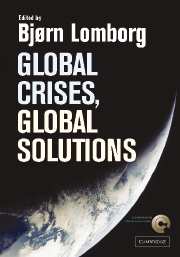Book contents
- Frontmatter
- Contents
- List of figures
- List of tables
- List of boxes
- List of contributors
- Acknowledgements
- List of abbreviations and acronyms
- Introduction
- PART I THE CHALLENGES
- 1 Climate change
- 2 Communicable diseases
- 3 Conflicts
- 4 Access to education
- 5 Financial instability
- 6 Governance and corruption
- 7 Malnutrition and hunger
- 8 Migration
- 9 Sanitation and access to clean water
- 10 Subsidies and trade barriers
- PART II RANKING THE OPPORTUNITIES
2 - Communicable diseases
Published online by Cambridge University Press: 22 September 2009
- Frontmatter
- Contents
- List of figures
- List of tables
- List of boxes
- List of contributors
- Acknowledgements
- List of abbreviations and acronyms
- Introduction
- PART I THE CHALLENGES
- 1 Climate change
- 2 Communicable diseases
- 3 Conflicts
- 4 Access to education
- 5 Financial instability
- 6 Governance and corruption
- 7 Malnutrition and hunger
- 8 Migration
- 9 Sanitation and access to clean water
- 10 Subsidies and trade barriers
- PART II RANKING THE OPPORTUNITIES
Summary
Summary
The Challenge of Communicable Disease
Between the 1950s and the 1990s, the world saw enormous health improvements. However, developing countries have benefited unequally from health gains, with many, especially in sub-Saharan Africa (SSA), continuing to experience high mortality. Children bear a major burden of ill health, with infectious and parasitic diseases the main killers. Adults experience substantial premature mortality. Within countries, poorer groups have considerably worse health than the better off. Analysis of avoidable mortality highlights the importance of communicable disease, which represents around 90 percent of all avoidable mortality in almost all age—sex groups. The benefits of research mean that tools and approaches now exist to address the great majority of communicable disease, most notably malaria, TB and HIV/AIDS, as well as vaccine preventable diseases. However, large numbers of people do not have effective access to prevention and treatment, and die as a result.
The chapter focuses on three opportunities:
Malaria control
HIV/AIDS control
Strengthening basic health services.
This categorisation has been chosen largely because malaria and HIV/AIDS are major causes of disease burden and economic losses; cost-effective interventions are known to exist for their control; there is recent literature which can be drawn on to estimate costs and benefits; and these diseases are currently the focus of world attention.
- Type
- Chapter
- Information
- Global Crises, Global Solutions , pp. 62 - 128Publisher: Cambridge University PressPrint publication year: 2004
- 18
- Cited by

